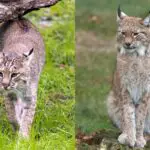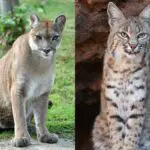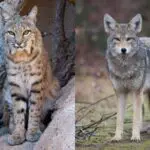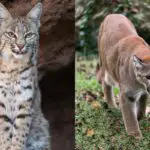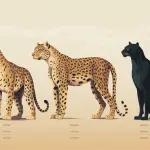There are multiple types of big cats living all over the world. While most of them are easily distinguishable, some are often mistaken for each other, even if they aren’t the same size and don’t share the same physical appearance.
Two big cats that often get mixed up are the mountain lion and bobcat. Sharing the same habitats, people seem to confuse the two regularly. That is despite the two cats being very different.
Of course, they do share some traits, like most species of cat do, but when you know more about each species, distinguishing between each cat is actually pretty easy.
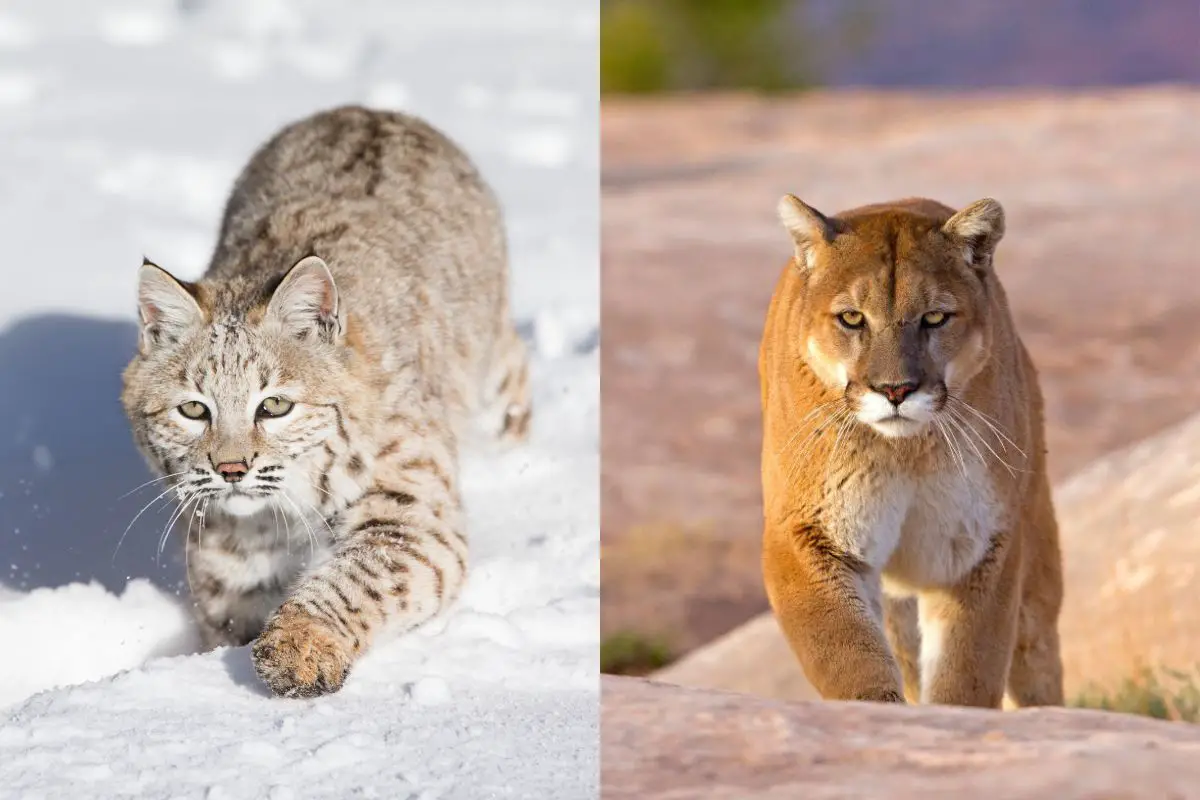
You might even be surprised by how different they are.
To give you a better understanding of the mountain lion and bobcat, we’ve put together this article.
In this article, we’ll show you the main differences between each species.
Stick around if you want to learn more!
Comparing Mountain Lion Vs Bobcat
Mountain lions and bobcats are two different species of cats. They both belong to a different genus.
The mountain lion belongs to the Puma genus, while the bobcat belongs to the Lynx genus. Having said that, they do both share the same family.
While the bobcat is believed to be the mountain lion’s most similar relative, the two are very different.
For starters, the mountain lion towers over the bobcat. The bobcat is only a medium-sized cat that reaches a maximum length of 49 inches.
On the other hand, mountain lions can grow to be 96 inches long.
Mountain lions also weigh almost 4 times more than bobcats and have a vastly different appearance.
Interestingly though, the bobcat is faster.
That’s about it though, as when it comes to bite power, height, weight, and aggression, mountain lions beat the bobcat every time.
When it comes to prey, both cats share some similarities. Both rely on their senses to hunt a wide range of prey. This can include deer, rabbits, mice, and birds.
Size
It is when looking at the size of both species that we can see the main differences between the bobcat and mountain lion.
To put it simply, the mountain lion is much bigger than the bobcat. Mountain lions can grow to be anything between 60 and 96 inches long.
The bobcat can only reach lengths of 49 inches long if it reaches maximum size.
The mountain lion can also weigh up to 130 lbs, while the bobcat usually weighs between 11 and 30 lbs. The lightest mountain lions still weigh 60 lbs, which is double that of a bobcat.
Mountain lions are taller too, reaching heights of approximately 36 inches tall. The bobcat reaches heights of roughly 24 inches tall.
The bobcat’s tail only reaches lengths of 2 to 7 inches, while the mountain lion’s tail can be up to 36 inches long.
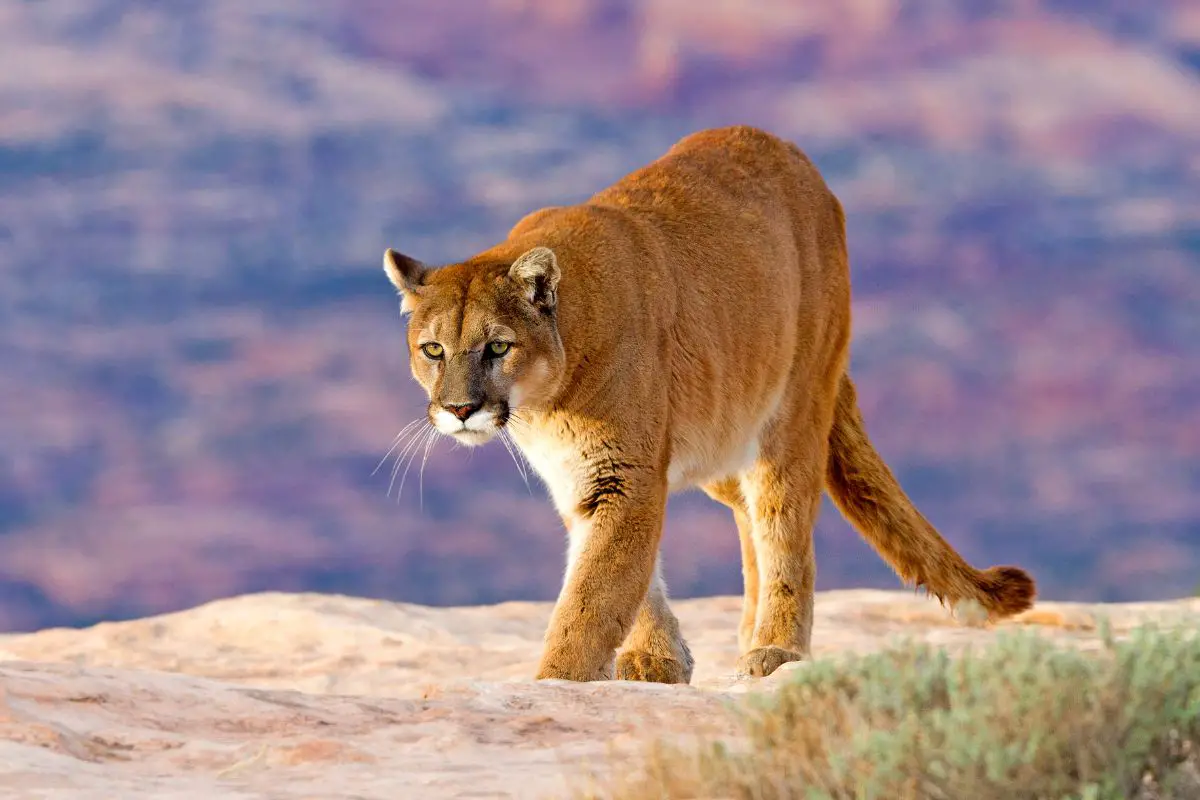
Speed And Movement
Interestingly, despite the significant difference in size, the bobcat is the faster of these two species.
Even though the species has smaller legs, the bobcat can run 5 mph faster than the mountain lion.
It’s worth noting though that the mountain lion isn’t slow. In fact, it’s actually quite quick, running at a respectable 30 mph when necessary.
They’re not as quick as the bobcat though, which can reach a top speed of 34 to 35 mph.
In terms of movement, neither species will use their top speed if possible. Instead, they will slowly stalk their prey on the ground before quickly pouncing.
They can use their power to rush their prey or even leap towards it.
Bite Power And Teeth
Mountain lions and bobcats have similar teeth. Like most cats, both species have canines, premolars, and molars.
Both cats will use their distinct, extremely sharp teeth to latch on to their prey during an attack.
Usually, the bobcat will have 28 teeth and the mountain lion will have 30.
While both cats have similar teeth, there are a few differences. The main difference between the two is that the mountain lion has a bigger bite power.
As a matter of fact, the mountain lion’s bite power is more than double that of a bobcat.
Mountain lions have a bite power of 1311 Newtons. The bobcat bite power is just 548 Newtons, which happens to be pretty impressive for a cat of its size.
The mountain lion’s teeth are also bigger.
Senses
Both the bobcat and mountain lion rely heavily on their senses to survive. Both cats use their senses to find prey, identify threats, and find a mate.
These cats have excellent vision and hearing, making it much easier for them to find their prey.
The bobcat also has an impressive sense of smell. This is one difference between the two cats as the mountain lion has a much worse sense of smell.
As a result, the bobcat has an advantage over the mountain lion when it comes down to senses.
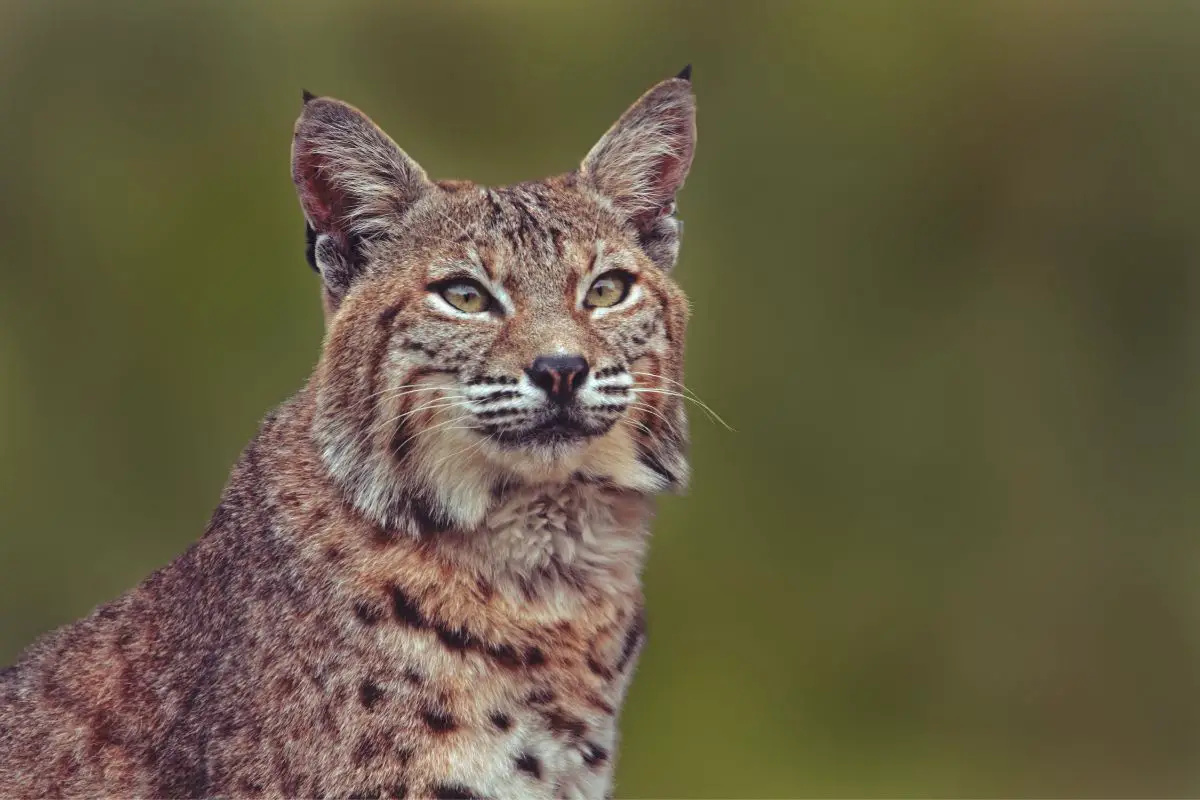
Physical Defenses
The best physical defenses an animal has are the ones they don’t need to use. This is often the case with the mountain lion.
Surprisingly difficult to spot, this stealthy cat has sharp teeth and claws. Of course, it can also use its speed to its advantage.
However, most of the time, the mountain lion doesn’t have to use any of these defenses as most animals are scared of them.
Bobcats aren’t as big, so they rely on their physical defenses more. They have speed on their side, as well as a terrifying scream that scares off potential enemies.
If push comes to shove, they also have their sharp teeth and retractable claws for help.
Offensive Capabilities
Interestingly, both of these cat species share similarities in regard to their offensive capabilities.
Both are formidable hunters that use the element of surprise to kill their prey. Fast, accurate, and aggressive, both cats use their advantages to quickly kill.
Despite being a much smaller predator, the bobcat has razor-sharp teeth and a large bite power for its size. It can also use its sharp retractable claws to climb and fight.
The mountain lion differs slightly in the way it will only normally use its teeth and powerful bite to kill. They very rarely use their claws to kill prey.
The main reason for this is that the mountain lion is much bigger and more powerful than the bobcat.
Predatory Behavior
The bobcat and mountain lion both use similar methods to hunt and kill their prey. Both will patiently stalk their prey, waiting for the opportune moment to strike.
When they do strike, they quickly pounce on their prey, going straight for the neck. Both cats aim to kill their prey with a single, fatal bite to the neck.
This bit usually disables the prey completely. The cats will then finish the attack with several other bites that kill the animal.
The main difference between the two is that the mountain lion wraps itself around its prey using its claws. This lets it subdue the prey, bringing it to the ground. Mountain lions tend to issue one fatal bit too.
Tracks
Spotting the differences between mountain lion and bobcat tracks is relatively easy. Due to their size, the mountain lion has much bigger tracks.
The track of a large male could be as much as 5 inches wide. A large male bobcat may only have tracks that are 2 inches wide.
Mountain lion tracks have a fairly big m-shaped pad. This then has two lobes towards the front and three towards the back of the pad. The front tracks are usually wider and larger.
Bobcat tracks resemble those of a small dog. The only real difference is that a bobcat’s tracks have a small notch at the front of the heel pad.
The bobcat’s front feet are also bigger than its back.
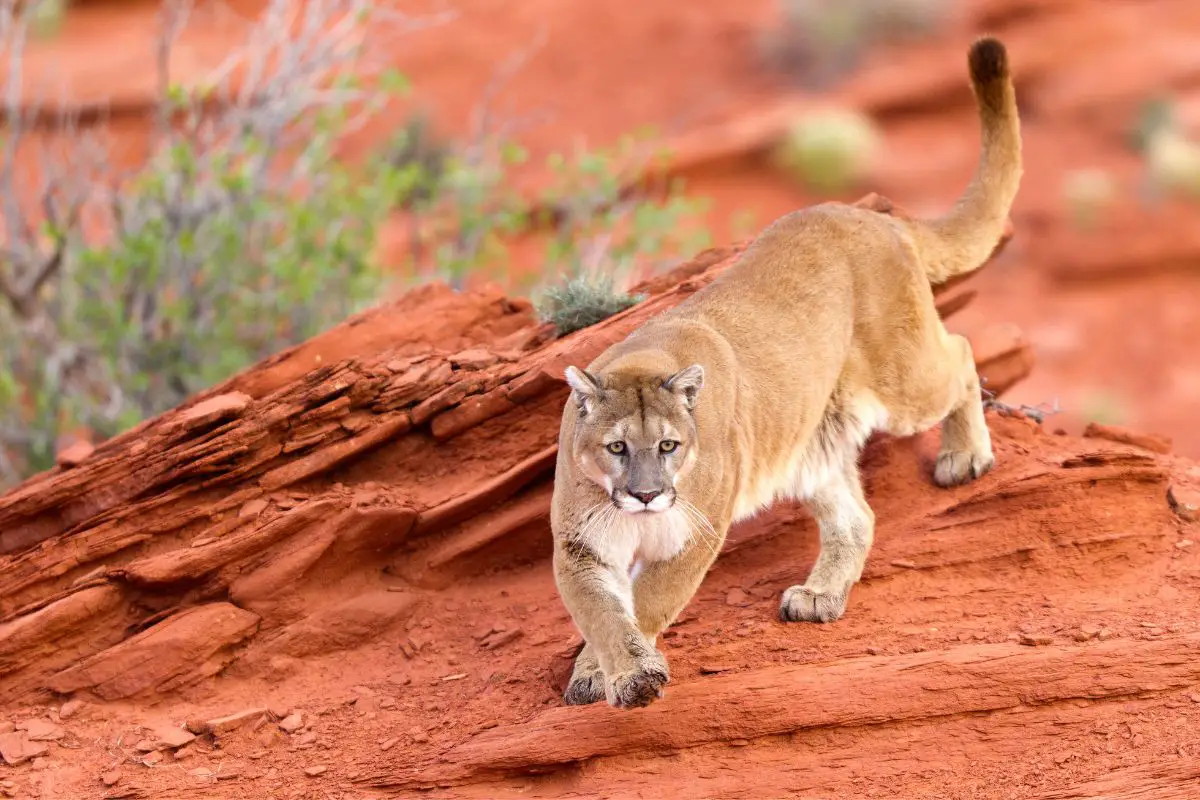
Length
Bobcats are much smaller than mountain lions. Males are bigger than females, but both can reach a maximum length between 26 and 41 inches long. The bobcat’s tail will then add another 2 to 7 inches onto their length.
More often than not, the average length of a female bobcat is 28 to 32 inches. A male will usually measure between 32 and 37 inches long.
Mountain lions are capable of reaching lengths of 60 to 96 inches long. That means that the smallest female mountain lions are still almost twice the size of most bobcats.
Weight
Mountain lions are also a lot heavier than bobcats. On average, a bobcat can weigh anywhere from 11 to 30 lbs. Compared to the mountain lion, this is very lightweight.
The mountain lion weighs anywhere from 60 lbs to 130 lbs. Even the heaviest bobcats are half the weight of an average-sized mountain lion.
Habitat
Bobcats and mountain lions tend to share similar habitats. Both species of cats are excellent at adapting to different environments and climates. Therefore, they can both be found in a wide range of habitats.
Making their home wherever shelter and prey can be found, mountain lions tend to live in mountain regions, deciduous and coniferous forests, wetlands, and deserts. This is similar to the bobcat.
Adapting to their surroundings, bobcats can also be found in wetlands, deciduous and coniferous forests, deserts, and mountain regions. They can also be found in urban areas.
Mountain lions have been known to stroll through urban areas but this is a lot less common.
Geographical Range
Both the bobcat and mountain lion have a wide geographical range. Found all over the United States, Canada, and parts of Mexico. However, bobcats currently have a wider geographical range than mountain lions.
Mountain lions are currently found in 14 western states. They used to live all the way across America, but the population number has reduced massively. Even in Florida, the small population is endangered.
The bobcat, on the other hand, is thriving. Found in 48 states across America, it is believed that between 2.3 and 3.5 million bobcats live in America.
To put this into perspective, there are believed to be just 20,000 to 40,000 mountain lions.
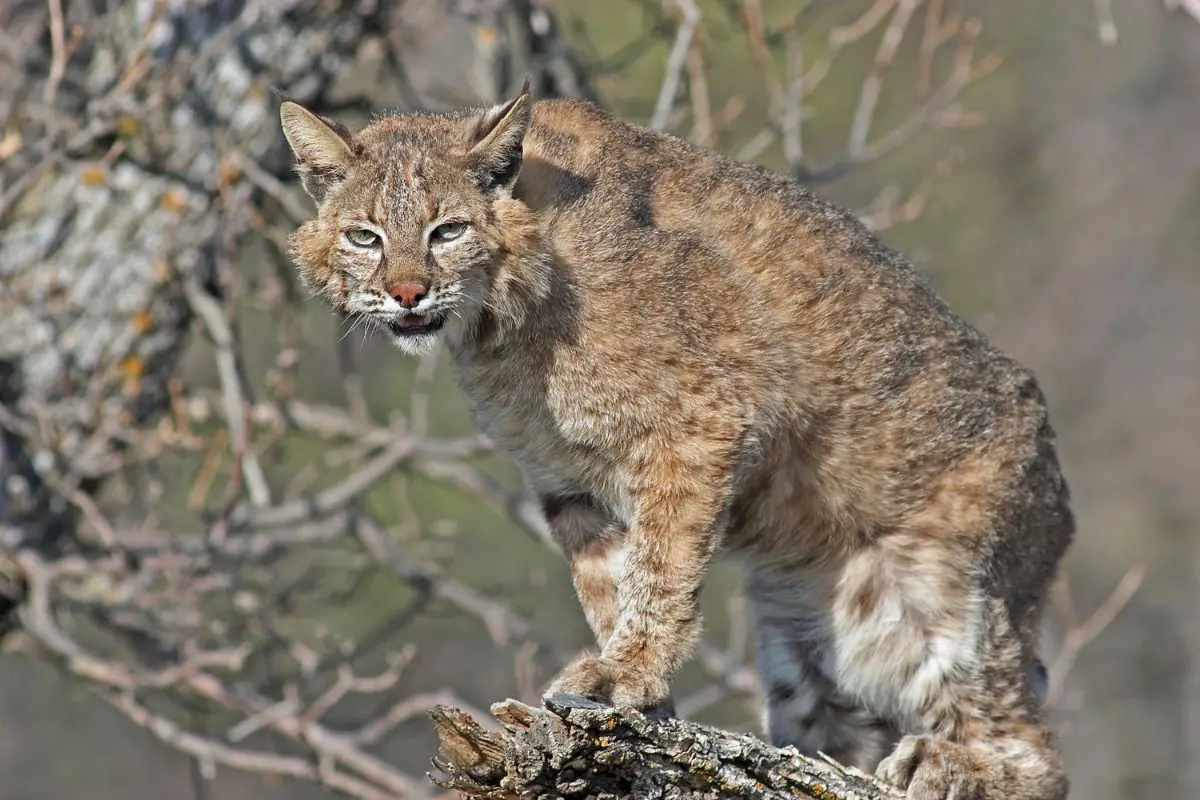
Body
Mountain lions are sleek, large predators, with graceful, flexible bodies and surprisingly small heads. They have long heavy legs, large paws, and sharp, slightly curved, retractable claws.
The mountain lion’s skull is broad and its forehead is highly arched. Inside their mouth, they have large, razor-sharp canines. They also have a long, powerful tail.
Bobcats also have long legs, large paws (for their size), and relatively small heads. They only have a short “bobbed” tail, a short body, and tufted ears. Compared to the mountain lion, they are much fluffier looking.
Range
Despite being found in fewer locations around the United States, mountain lions have a much larger range than bobcats.
A mountain lion’s range can vary in size massively. Their range could be anywhere from 25 to an astonishing 400 square miles.
Of course, this depends on the lion’s hunting and shelter needs and requirements.
Compared to the bobcat, this range is extremely big. On average, bobcats only have a range of 6 to 25 square miles. If possible, a bobcat might choose to never leave its territory.
Legs And Feet
Both mountain lions and bobcats have long legs for their size. Both also have longer hind legs than their front legs. For obvious reasons, the bobcat does have shorter legs than the mountain lion.
The bobcat’s legs also give it a “bobbing gait”. As a result of its legs, the bobcat is capable of leaping 12 feet into the air. Their paws are also quite large at approximately 2 inches wide and long.
The mountain lion’s legs give it enough power to vertically leap 15 feet into the air. This is possible thanks to their muscular hind legs.
Their paws are approximately 5 inches wide which is 3 inches bigger than the bobcat’s paws.
Fur Color And Patterns
In terms of fur color and patterns, it is easier to understand why people confuse the two species of cat.
Both the bobcat and mountain lion have light brown, yellowish, and sometimes light gray fur and a white underbelly. Some even have a coat that is slightly red in color.
Having said that, there are some differences. The fur on a bobcat, particularly around its ear, is much fluffier and tuft than that on a mountain lion. Mountain lions have a shorter, more sleek coat.
When it comes to patterns, the bobcat is somewhat spotted with dark brownish-gray markings. These markings can be found all over its coat.
A mountain lion’s coat can be free from any markings or again be spotted with dark brown marks.
Tails
The bobcat only has a small “bobbed” tail. It is actually the bobcat’s tail that gives the cat its name. This tail typically reaches lengths of 2 to 7 inches, which is very small, even for its size.
On the other side of things, mountain lions have large tails. A mountain lion’s tail can grow to lengths between 30 and 36 inches. That’s as long as most bobcats.
Both species of cat have a black-tipped tail.
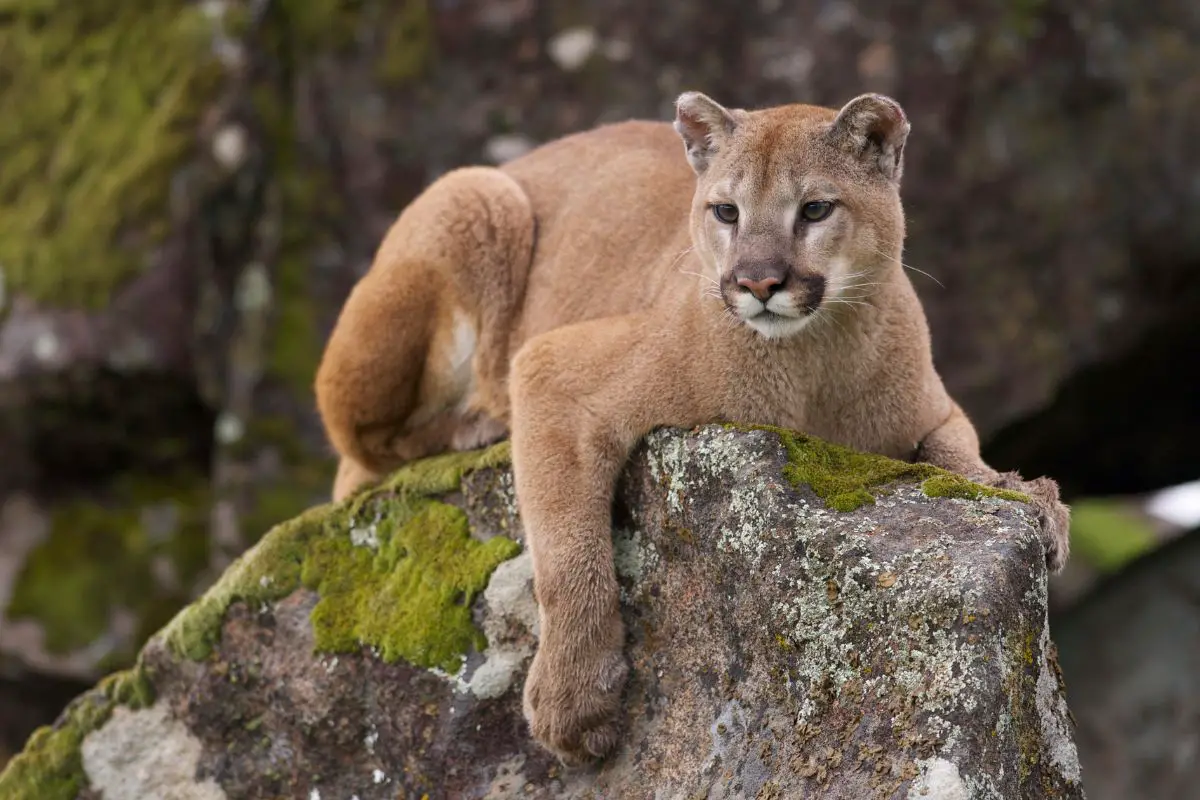
Who Would Win In A Fight Between Mountain Lion And Bobcat?
Despite being known for taking down predators much bigger than themselves, the bobcat would easily lose a fight against a mountain lion. Mountain lions are simply too big and too powerful for the bobcat.
The fight would probably play out with one of the cats stalking the other.
However, even if the bobcat used its better sense of smell to stalk and attack a mountain lion, its bite power isn’t enough to instantly kill the mountain lion.
This would then give the mountain lion time to easily overpower and kill the bobcat.
The bobcat might be able to cause damage and move quicker, but the mountain lion could kill the bobcat with one bite.
Will A Mountain Lion Eat A Bobcat?
Unfortunately, yes, a mountain lion would eat a bobcat.
While the bobcat might not represent the preferred choice of food for a mountain lion, as they prefer to hunt deer, sheep, and rodents, a mountain lion wouldn’t pass up the opportunity to snack on a bobcat if the opportunity arose.
A chance encounter could be the end for the cute bobcat just minding its own business.
What Are A Mountain Lions Weaknesses?
Mountain lions don’t have too many weaknesses. They are skilled hunters and fierce predators that are feared by most animals.
However, they do have a few weaknesses. In terms of their hunting performance, their sense of smell is very poor.
Aside from that, the mountain lions’ biggest weakness is us.
Due to hunting, habitat destruction, and global warming, the mountain lion population is endangered in a number of locations. In some, they have even been wiped out.
Final Thoughts
There you have it, everything you need to know in relation to the main differences between the bobcat and mountain lion. As you can see from this article, mountain lions and bobcats differ a lot.
Despite being mistaken for each other regularly, the two species have a wide range of differences. The main differences between the two are size, power, weight, and fur.
Even though the two species are very different, we can all agree that both cats are incredibly majestic, fierce, and extremely skilled hunters.
Hopefully, you now know everything there is to know about bobcats and mountain lions and how to distinguish between the two.
- Sink Your Teeth Into This: Analyzing the Powerful Lion Bite Force - September 8, 2023
- Siberian Tigers: Everything You Need To Know - September 4, 2023
- Do Lions Eat Humans? Understanding Lion Aggression and Risks - September 4, 2023


